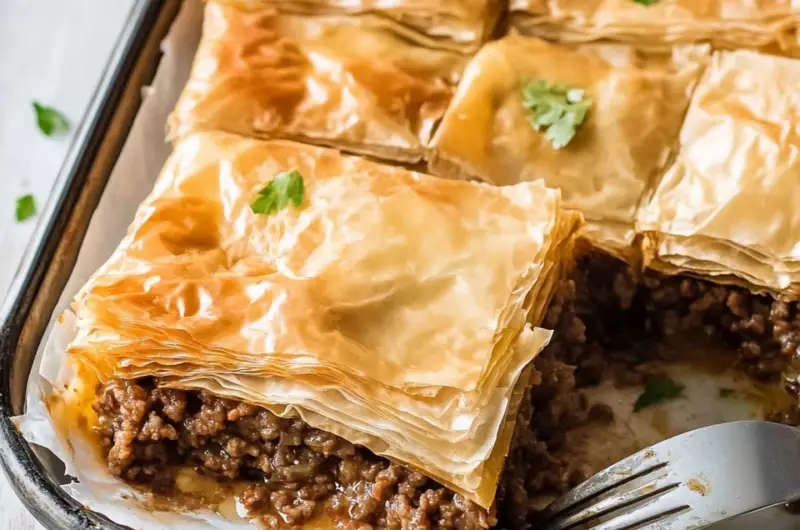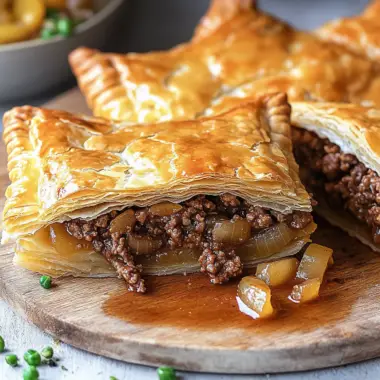The Egyptian Goulash, or “Goulash Masri,” is a staple in many Middle Eastern households, particularly across Egypt. This dish is not to be confused with Hungarian goulash it’s a savory baked meat pie composed of layers of delicate phyllo dough, butter, and a spiced beef filling. Its appeal lies in the contrast between the crispy, golden crust and the soft, flavorful filling within. It’s often served during holidays, family dinners, or festive gatherings. What makes this dish special is its simplicity and rich taste. The addition of cinnamon to the beef gives the filling a warm, aromatic quality that pairs beautifully with the buttery phyllo. It’s easy to prepare, economical, and impressively satisfying making it ideal for both everyday meals and special occasions. You can serve it hot out of the oven or even at room temperature, and it pairs beautifully with yogurt or a simple salad.
Full Recipe:
Ingredients:
-
1 package phyllo dough, thawed
-
500g ground beef
-
1 medium onion, finely chopped
-
3 tablespoons butter (melted)
-
1/2 cup milk
-
2 eggs
-
1/2 teaspoon cinnamon
-
Salt and pepper to taste
-
2 tablespoons vegetable oil
-
1/4 cup beef broth (optional for extra moisture)
Directions:
-
Preheat your oven to 375°F (190°C). Grease a 9×13 inch baking dish.
-
In a skillet, heat oil and sauté onions until soft. Add the ground beef, cinnamon, salt, and pepper. Cook until browned. Drain any excess fat and set aside to cool slightly.
-
Layer half the phyllo sheets in the greased dish, brushing each sheet with melted butter.
-
Spread the cooked beef mixture evenly over the layered phyllo.
-
Cover with the remaining phyllo sheets, brushing each layer with butter again.
-
Using a sharp knife, cut the layered pie into squares or diamonds before baking.
-
In a bowl, whisk the eggs and milk together. Pour evenly over the pie.
-
Bake for 40-45 minutes, or until golden brown and crisp on top.
-
Allow to rest for 5-10 minutes before serving.
Prep Time: 15 minutes | Cooking Time: 45 minutes | Total Time: 1 hour
Kcal: 310 kcal | Servings: 8 servings
Egyptian Goulash: A Layered Legacy of Flavor and Comfort
Egyptian Goulash known locally as “Goulash Masri” (جولاش مصري) is a hidden gem in the realm of Middle Eastern cuisine. Often confused with its Hungarian namesake, this dish stands proudly as its own unique creation: a rich, savory meat pie made with layers of flaky phyllo pastry, spiced minced beef, and a delicate egg-milk custard poured over the top before baking. With its comforting warmth and golden crust, it holds a special place on dinner tables across Egypt and beyond, bringing with it nostalgia, tradition, and irresistible flavor.
Whether served as a family weeknight dinner, a festive Ramadan offering, or part of a mezze spread for guests, Egyptian Goulash is a versatile dish that combines accessible ingredients with unmistakable Middle Eastern flair. Let’s dive deep into its cultural significance, culinary appeal, variations, and serving suggestions.
The Origins and Cultural Relevance of Egyptian Goulash
Although it shares its name with the Hungarian stew, Egyptian Goulash couldn’t be more different. This savory pastry dish traces its roots back to Ottoman influences that swept through North Africa and the Middle East. The use of phyllo dough (or “goulash pastry” in Egyptian Arabic) and richly spiced fillings harken to the culinary practices introduced during Ottoman rule, which brought layered pastries and meat pies into the region’s kitchens.
In Egypt, Goulash evolved into a beloved staple, particularly valued for its balance of crisp texture and hearty filling. It is often served during Ramadan, Eid feasts, and family celebrations, symbolizing both abundance and hospitality. Many Egyptians associate this dish with gatherings at home, where the smell of baked phyllo and beef fills the air, signaling comfort and joy.
Why Egyptian Goulash Stands Out
What sets Egyptian Goulash apart from other savory pastries is its combination of texture and simplicity. The crispy, buttery phyllo dough provides a light yet satisfying contrast to the seasoned beef filling inside. Unlike overly complex dishes that require hard-to-find spices or advanced culinary skills, this dish relies on a few well-chosen seasonings like cinnamon, black pepper, and sometimes a hint of nutmeg to bring warmth and depth to the meat.
Another defining feature is the egg-and-milk mixture that is poured over the pastry before baking. This not only binds the layers together but also creates a custard-like richness in the finished pie, ensuring that the filling remains moist while the top turns beautifully golden and crisp.
Its ability to be prepped ahead of time and stored in the fridge or freezer also adds to its popularity among home cooks. Egyptian Goulash is just as enjoyable freshly baked as it is reheated the next day, making it ideal for leftovers, meal planning, and packed lunches.
Textural Harmony: The Role of Phyllo Dough
Phyllo dough is the backbone of this dish. Known for its paper-thin, fragile texture, phyllo becomes beautifully crisp and golden when brushed with butter and baked. Layering the sheets typically half beneath the filling and half on top ensures a uniform structure that can hold its shape while allowing each bite to melt in your mouth.
The key to working with phyllo dough lies in speed and moisture control. Because the sheets dry out quickly, they should be kept covered with a slightly damp towel while assembling the dish. Brushing each layer with melted butter or oil ensures flakiness and flavor, turning the simple dough into something sublime.
The Filling: A Masterpiece of Simplicity
At the heart of the dish lies the beef filling. Ground beef, onions, and a select blend of spices come together in a skillet before being layered into the phyllo. Cinnamon is often the star of the spice mix unexpected in a savory dish, but integral to the distinctly Egyptian flavor profile. Its sweet warmth elevates the beef, creating a subtle, aromatic note that makes the dish stand out.
Some cooks add pine nuts, bell peppers, or finely chopped parsley for variation, though many purists prefer the minimalist approach that keeps the spotlight on the rich, savory beef.
The Custard Finish: Moisture Meets Magic
The egg-and-milk mixture that’s poured over the top of the assembled pie before baking serves a dual purpose. It infuses the goulash with additional flavor and moisture, while also acting as a gentle binder that holds the phyllo and beef together. This final touch creates a soft, custard-like interior under the crisp surface a sensory contrast that is both comforting and indulgent.
Many variations also include a splash of broth or cream in this custard layer to intensify the richness or stretch the custard over a larger tray.
Serving and Presentation Suggestions
Egyptian Goulash is typically baked in a rectangular or square pan, then cut into uniform squares or diamond shapes. These tidy portions make it easy to serve at buffets, picnics, or family-style meals.
It pairs exceptionally well with sides like:
-
A simple cucumber and tomato salad
-
Yogurt with mint or garlic
-
Pickled vegetables
-
Lentil soup or chickpea-based dips
Served warm or at room temperature, it can be part of a larger feast or enjoyed on its own as a main dish. For those looking for a lighter touch, a fresh green salad with lemon vinaigrette offers a refreshing counterpoint to the buttery pastry.
Variations and Customizations
One of the strengths of Egyptian Goulash is how customizable it is. Here are a few common and delicious variations:
-
Cheese Goulash: Replace or combine the beef with white cheese (like feta or ricotta) and fresh herbs. This version is popular for lighter meals.
-
Chicken Goulash: Use finely chopped or shredded chicken breast with onions and your choice of spices paprika and cumin work beautifully.
-
Vegetarian Goulash: Substitute the meat with sautéed mushrooms, eggplant, spinach, or lentils. Still hearty, still flavorful.
-
Spicy Goulash: Add chopped chili peppers or a pinch of cayenne to the filling for extra heat.
-
Sweet Goulash: While rare, some Egyptian families prepare a dessert version with nuts, sugar, and cinnamon similar to baklava.
These adaptations can make the dish suitable for various diets, occasions, or taste preferences.
Nutritional Insight
Despite its indulgent taste and buttery crust, Egyptian Goulash can be part of a balanced diet. When prepared with lean ground beef and portioned reasonably, it offers a good mix of protein, carbs, and fats. For a lighter version, use reduced-fat milk, fewer phyllo layers, or swap in olive oil for butter.
Each serving (based on 8 pieces) provides approximately 300–350 calories, with ample protein and satisfying richness. Pairing it with fresh vegetables and skipping other heavy dishes can make it a wholesome, one-plate meal.
Conclusion:
Egyptian Goulash is more than just a recipe it’s a comforting slice of culture, layered with history, flavor, and community. Its flaky, golden top gives way to a rich, spiced center that appeals to a broad spectrum of palates, from kids to grandparents. Whether you’re introducing it to a new audience or recreating childhood memories, this dish never fails to impress.
As food trends shift and evolve, Egyptian Goulash remains timeless. Its reliance on humble ingredients, minimal fuss, and the warm flavor of cinnamon and beef ensures that it will continue to be passed down through generations. This recipe is ideal for cooks seeking to expand their culinary horizons with an authentic, beloved dish from the heart of Egypt.








